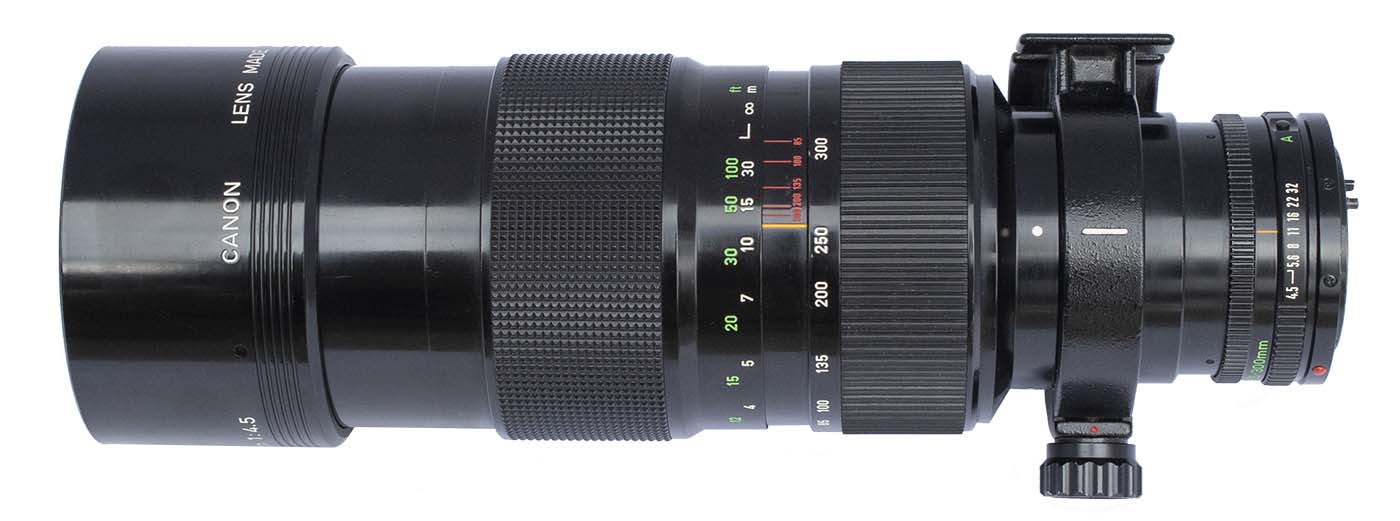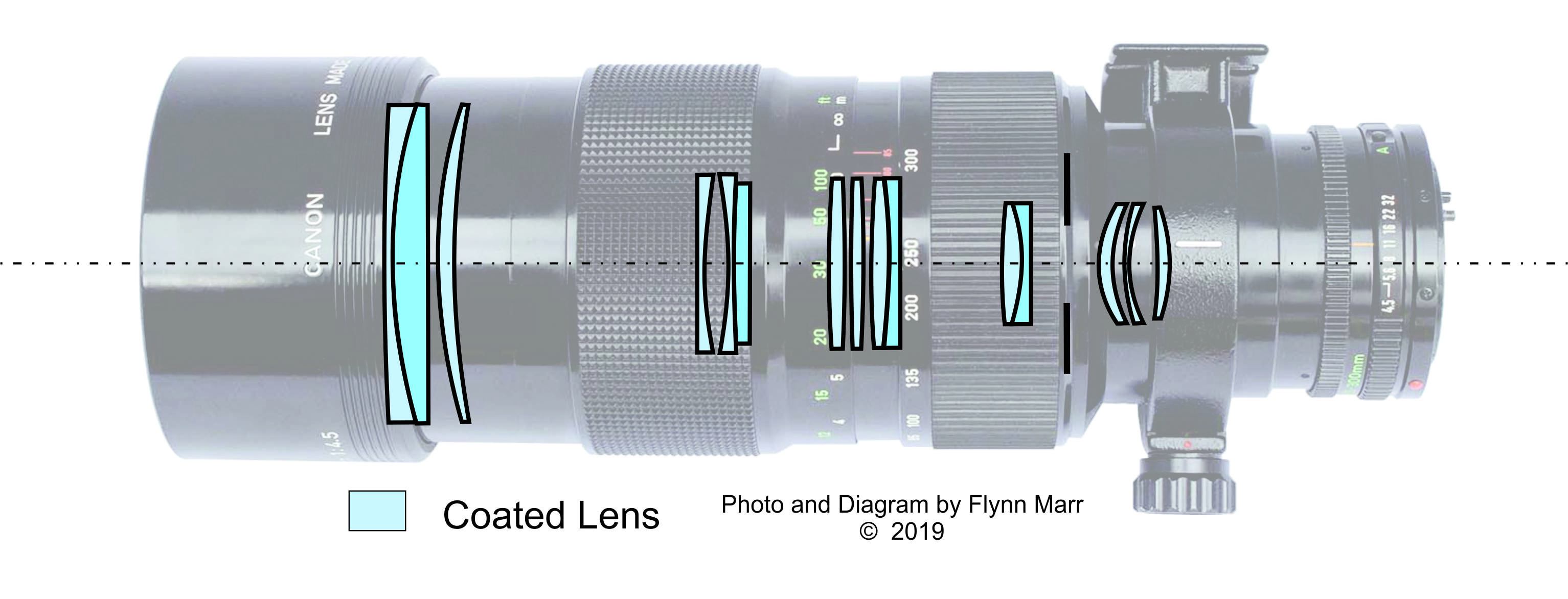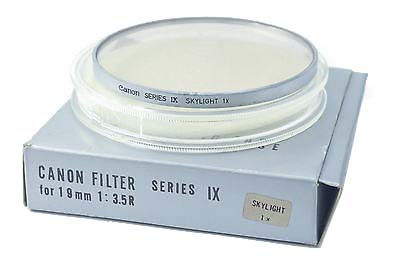FDn 85-300mm f/4.5
Canon began with an FL 85 to 300mm zoom
lens in 1965 and followed that up with an
updated version in the FD series in 1974.
The last of these lens was an FDn version, the one we are looking at here.
This is a large heavy lens in a beautiful black finish. It has a built in lens hood and comes with a lens mount collar that allows the lens, and thus the camera, to rotate ninety degrees to go from landscape to portrait mode. The zoom is internal and does not affect overall length of the lens. However, focusing does change the length of the lens and the front element rotates.
The Canon Museum says that this lens takes “Series IX” filter but my copy takes a standard 82mm filter screwed on over the front element.
We have a Newsletter
There is a Newsletter for thecanoncollector.com to keep you up to date on what we are posting. Try it!
Relying on the information available in the Canon Online Museum a summary of the 85-300mm zoom lens models looks like this:
| FDn | FD S.S.C. | FL | |
| Date of Introduction | January 1981 | April 1974 | April 1965 |
| Number of Lens Groups | 11 | 11 | 9 |
| Number of Individual Lenses | 15 | 15 | 15 |
| Max. Aperture | 4.5 | 4.5 | 5.0 |
| Min. Aperture | 32 | 22 | 22 |
| Number of Iris Blades | 8 | 8 | 6 |
| Minimum Focus Distance (meters) | 2.5 | 2.5 | 4 |
| Filter | Series IX* | Series IX | 72mm |
| Weight (grams) | 1630 | 1800 | 1850 |
- Although the Canon Museum says that the FDn takes the Series IX filter, my copy of this lens also accepts a standard 82mm screw in filter.
The size of this lens is apparent when viewed mounted on a Canon F-1. It is shown
with a standard 82mm filter mounted over the front element. The lens hood
is retracted to that the filter and front element are visible. Because of the
weight of this lens it is a bad practice to mount this setup on a tripod
using the camera tripod mount. It puts too much
strain on the camera body.
The lens is
provided with its own tripod
attach point which has the advantage of allowing the
lens to rotate between portrait and landscape mode. The lens-camera
combination balances very nicely when using the lens attach collar. This collar
removes easily by losening the clamp knob (visible here) and then pulling it straight out
and then opening the collar.
Shooting with the 85-300mm
So what is it like shooting with this lens and how does it perform? Again, I mounted it on my Canon R, setting the camera to aperture priority. This meant that I could set my aperture and the camera would adjust shutter speed for correct exposure. The first thing that became apparent: this is not a walkabout lens! It is heavy and awkward to handle. Having to focus, then stop down to the desired f/stop, then shoot, takes three hands (one more than I have currently!) And then there is camera shake. Because it is heavy and because it is a long lens, both optically and physically, the image jumps all over the viewfinder. This is a lens for a tripod or, at the very least, a monopod!
Having found out these things very quickly, not really any surprises here, I used a tripod for my test exposures. I made no attempt at pretty pictures. I just set up on the front porch and shot pictures of the house across the street.
At 300mm
You don’t expet a lens to be at its best at either end of its range but you have to start somewhere so we’ll start at the 300mm end. The image on the left is full frame at 300mm at f/11. This is not a rigourous analysis of the lens so we will examine it at f/11 where the defects should be minimal. Sharpness here is pretty good. Color is not great but the day was dull and overcast making for flat colorless lighting. The middle image is at 200% and centers on the house number. The right image is a simple enlargement of the numerals to examine the image closer.
At 200mm
These three are at 200mm which is closer to the center of the lens’s range. At 200% (center image) the sharpness is excellent. On the right the numerals have been enlarged. Remember that this image is a higher magnification than the one above it because it is from a shorter focal length. Even so, sharpness holds up pretty well. There is some color fringing beginning to show but it is minor.
At 85mm
On the left is the full frame at 85mm f/11. The middle is at 200%. On the right the image is now enlarged very much more that the images immediately above. It may seem much softer but look closelly and you will see it has been enlarged to the point that it is heavily pixelated. Remember that this is a 30 megapixel image so the enlargement is extreme!
There are really no surprises here. This lens is excellent and, for the films it was designed for, more than adequate. It is softer at both ends of the focal range but acceptably so. Fall off in the corners is well controlled and sharpness to the edges of the frame is very good.
These images are all at f/11 where you expect good performance. Although I have not shown the results wide open at f/4.5 however I can tell you that they were much softer and the color fringing more prominent. Shooting wide open with this lens is to be avoided where possible.
Although taken at F/8.0 the depth of field in this image is very shallow and some of the blossoms are not in sharp focus. However, notice the very smooth pleasant bokeh this lens creates in the background.
This is a lens for action photography or wildlife images. Not having any sports games at hand and not having the patience for wildlife I still wanted to see what this lens was like to actually use in the real world, I ignored all of my comments above and took it for a simple walkabout mounted on my Canon R ……. no tripod or monopod. It was a challenging outing, to say the least. My first impression was the weight.
This is not a pleasant piece of equipment to carry. Not only that, it seems to be all angles and corners when holding it. It is not comfortable to grip. I immedaitely felt the lack of a tripod.
All three of these images were taken between 200 and 300mm and at f/8.0. I relied heavily on the “focus peaking” feature in the camera. With my old eyes I do not believe I could have accurately focused the lens without it. Both the focus ring and zoom ring were buttery smooth and easy to rotate. I did notice that at f/8.0 the depth of field is shallow.
I would have liked to stop down further but I also wanted a high shutter speed to compensate for the camera shake, hand held as it was. To this end I also pushed the ISO setting to 400 so that my shutter speeds were generally between a 350th and a 1000th.
To take pictures this way I found myself much busier than I am with an EOS lens on the camera. I had to manually set and operate the aperture, focus the camera, which was difficult even with focus peaking, adjust the zoom, all the while holding a very heavy and awkward piece of equipment. And without image stabilization, I had to concentrate on breath and muscle control to steady the image in the viewfinder.
But, all of that aside, I was able to take decent pictures hand holding this lens. But it was a lot of work. It is interesting and enjoyable to shoot these old lenses, but at the end of the day, when I go to do serious photography, I’ll take my EOS system.
In the center of the image you can see the hairs on the flower stems which have been captured by this lens. This is an almost full frame image.
A full frame image of a construction crane. The cab of the crane is six floor up and I am standing below, on the ground, across the street from it.
You will note in the Table of Lenses above that the FDn and FD S.S.C. lenses call for “Series IX” filters. When I was writing this article I realized that I was not sure what these “Series” filters were or where they went on the lens. On investigation I learned that these filters are not a Canon device but a form of general photography filter used from the 1930’s through to the 1970’s when they slowly faded from use.
There are two pieces to this filter: a filter holder usually constructed in two pieces that screw into each other that pushes or, in some cases, screws onto the front of the lens, and a filter element, usually a round piece of glass, that is held in place between the two pieces of the filter holder. As a general rule different diameters were denoted by Roman Numerals and half sizes by Arabic Numerals although there are some exceptions to the general rule.
The image on the left is the Canon Filter Holder and the center and right hand images are of the filter itself. In any size you only need one filter holder and you can have multiple filters. The holder may not be threaded and simply push onto the front of the lens. It may be a push fit or have a screw to tighten the holder on the lens.Some holders were threaded and screwed into the front of the lens. (Images are from old listings on E-bay. I have none of these filters in my collection (yet),
The “Series” filters originated in the United States and as a result were designated, originally, in Imperial units. The sizes of these filters can be summarized as follows:
| Filter Type | Filter Diameter |
Retaining Ring Size | Lens Diameter | ||
| Series IV (4) | 13/16th Inches | 20.3 mm | 15/16th Inches | 23.8 mm | 16-18 mm |
| Series 4.5 | 1 Inch | 25.4 mm | 1 1/8th Inches | 28.6 mm | 19-35 mm |
| Series V (5) | 1 3/16th Inches | 30.2 mm | 1 5/16th Inches | 33.3 mm | 19-30 mm |
| Series 5.5 | 1 19/32 inches | 40.5 mm | 1 23/32 Inches | 43.7 mm | 31-40 mm |
| Series VI (6) | 1 5/8th Inches | 41.3 mm | 1 3/4 Inches | 44.5 mm | 31-42 mm |
| Series 6.5 | 1 7/8th Inches | 47.6 mm | 2 inches | 50.8 mm | 43-48 mm |
| Series VII (7) | 2 Inches | 50.8 mm | 2 1/8th Inches | 54.0 mm | 43-51 mm |
| Series 7.5 | 2 1/4 Inches | 57.2 mm | 2 3/8th Inches | 60.3 mm | 52-57 mm |
| Series VIII (8) | 2 1/2 Inches | 63.5 mm | 2 5/8th Inches | 66.7 mm | 52-67 mm |
| Series 8.5 | 2 15/16th Inches | 74.6 mm | 3 1/16th Inches | 77.8 mm | 67-75 mm |
| Series IX (9) | 3 1/4 Inches | 82.6 mm | 3 7/16th Inches | 87.3 mm | 67-85 mm |
| Series 93 | 3 21/32nd Inches | 92.8 mm | 3 25/32nd Inches | 96.0 mm | 86-93 mm |
| Series 103 | 4 1/16th Inches | 103 mm | 4 3/16th Inches | 106 mm | 86-103 mm |
| Series 107 | 4 7/32nd Inches | 107 mm | 4 11/32nd Inches | 110 Inches | 86-107 mm |
| Series X (10) | 4 1/2 Inches | 114 mm | 4 5/8th Inches | 117 mm | 86-114 mm |
| Series 119 | 4 11/16th Inches | 119 mm | 4 13/16th Inches | 122 mm | 115-119 mm |
| Series 125 | 4 15/16th Inches | 125 mm | 5 1/16th Inches | 128 mm | 115-125 mm |
| Series XI (11) | 5 7/16th Inches | 138 mm | 5 9/16th Inches | 141 mm | 115-138 mm |
So, in summary, this is a great lens although, by today’s standards, awkward to use. In all these considerations of old lenses we must always remember the medium they were designed for. Film is no match for a 30 megapixel sensor. If the lens does well on the Canon R you can be assured that it will perform beautifully on film.




















